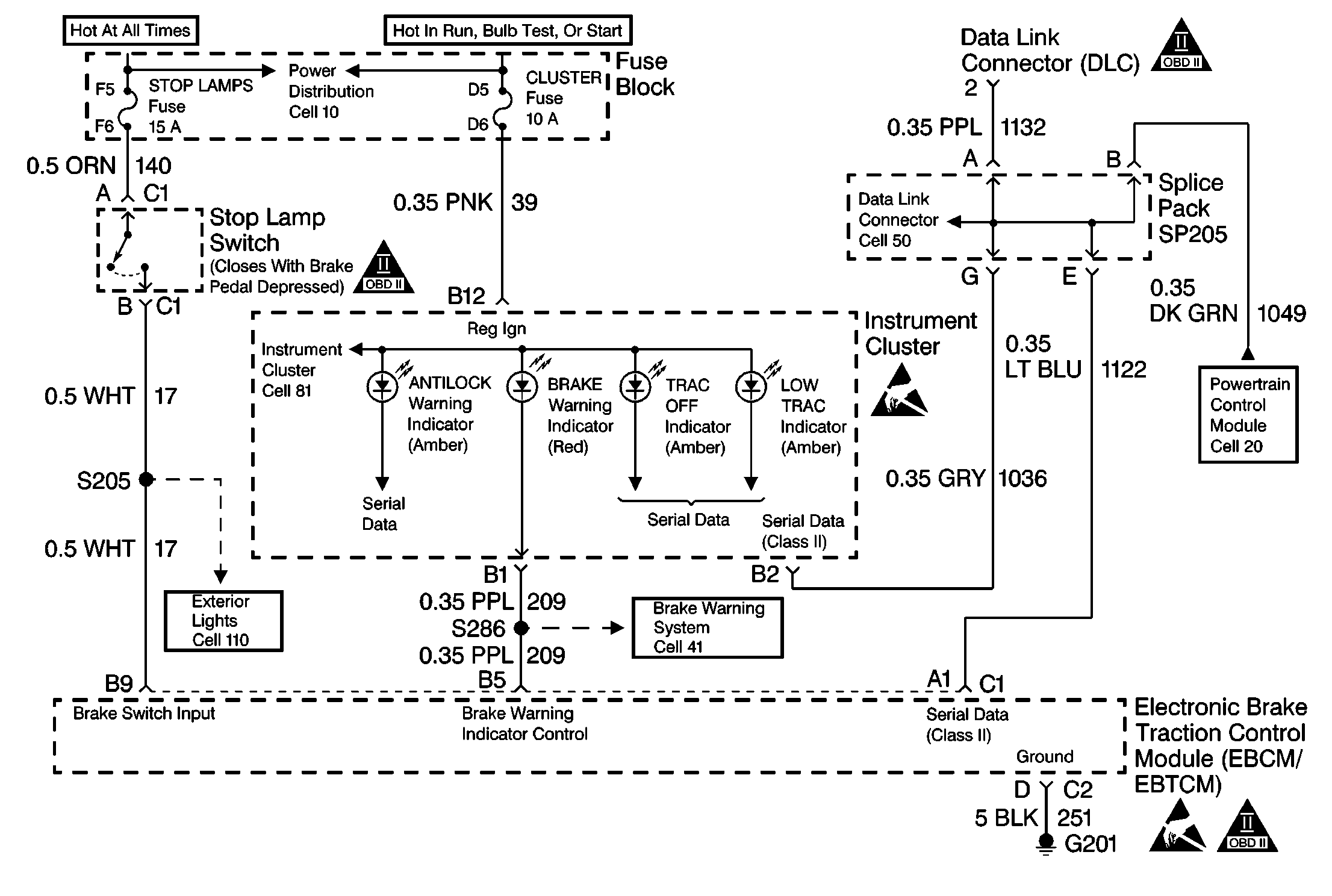
Circuit Description
The serial data communications circuits (CKT 1122, CKT 1132 and CKT 1049) is used to transmit messages from one electronic control module to another when interface is necessary between systems. The ABS/ETS/TCS systems depends on information to and from the PCM for proper operation.
Conditions for Setting the DTC
DTC U1300 sets when there is a short to ground on the Serial Data Line for four seconds.
Action Taken When the DTC Sets
| • | A malfunction DTC stores. |
| • | The ETS/TCS disables. |
| • | The amber ETS/TCS OFF indicator (TRAC OFF) turns on. |
The ABS remains functional. No action towards the electronic brake control relay and ABS warning indicator is taken.
Conditions for Clearing the DTC
| • | The condition responsible for setting the DTC no longer exits and the Scan Tool Clear DTCs function is used. |
| • | 100 drive cycles pass with no DTCs detected. |
Diagnostic Aids
Before beginning this DTC table, perform a Powertrain OBD System Check in order to eliminate the PCM as the possible source of the malfunction.
The following conditions may cause an intermittent malfunction:
| • | A poor connection |
| • | Rubbed-through wire insulation |
| • | A broken wire inside the insulation within the Serial Data Line. Refer to Data Link Connector Cell 50 in Electrical Diagnosis. |
Use the enhanced diagnostic function of the Scan Tool in order to measure the frequency of the malfunction. Refer to the Scan Tool manual for the procedure.
Thoroughly inspect any circuitry that may cause the intermittent complaint for the following conditions:
| • | Backed out terminals |
| • | Improper mating |
| • | Broken locks |
| • | Improperly formed or damaged terminals |
| • | Poor terminal-to-wiring connections |
| • | Physical damage to the wiring harness. |
Step | Action | Value(s) | Yes | No |
|---|---|---|---|---|
1 | Was the Diagnostic System Check performed? | -- | Go to Diagnostic System Check | |
2 |
Can you establish communication with other modules connected to the serial data line? | -- | ||
3 |
Is the resistance measured within the specified range? | OL (Infinite) | ||
4 |
Is the frequency (Hz) measured greater then the specified value? | 10 Hz | ||
5 |
Is the frequency (Hz) measured greater then the specified value? | 10 Hz | ||
6 |
Is the frequency (Hz) measured greater then the specified value? | 10 Hz | ||
7 |
Is the frequency (Hz) measured greater then the specified value? | 10 Hz | ||
8 |
Is the frequency (Hz) measured greater then the specified value? | 10 Hz | ||
9 |
Are there signs of poor terminal contact, evidence of terminal corrosion, or terminal damage? | -- | ||
10 | Replace all terminals or connectors that exhibit signs poor terminal contact, corrosion, or damaged terminal(s). Is the repair complete? | -- | Go to Diagnostic System Check | -- |
11 | Repair the short to ground in Serial Data Line. Refer to Data Link Connector Cell 50 in Electrical Diagnosis. Is the repair complete? | -- | Go to Diagnostic System Check | -- |
12 | Repair the short to ground in instrument cluster. Refer to Instrument Cluster Cell 81 in Electrical Diagnosis. Is the repair complete? | -- | Go to Diagnostic System Check | -- |
13 | Repair the short to ground in heater A/C control. Refer to HVAC Blower Controls Cell 66 in Electrical Diagnosis. Is the repair complete? | -- | Go to Diagnostic System Check | -- |
14 | Repair the short to ground in Body Control Module (BCM). Refer to Body Control Module (BCM) Cell 51, in Electrical Diagnosis. Is the repair complete? | -- | Go to Diagnostic System Check | -- |
15 | Repair the short to ground in Powertrain Control Module (PCM). Refer to Engine/Engine Controls, Powertrain OBD System Check for diagnosis. Is the repair complete? | -- | Go to Diagnostic System Check | -- |
16 | Replace the EBCM/EBTCM. Is the repair complete? | -- | Go to Diagnostic System Check | -- |
17 | The malfunction is intermittent or is not present at this time. Is the repair complete? | -- | Go to Diagnostic Aids | -- |
